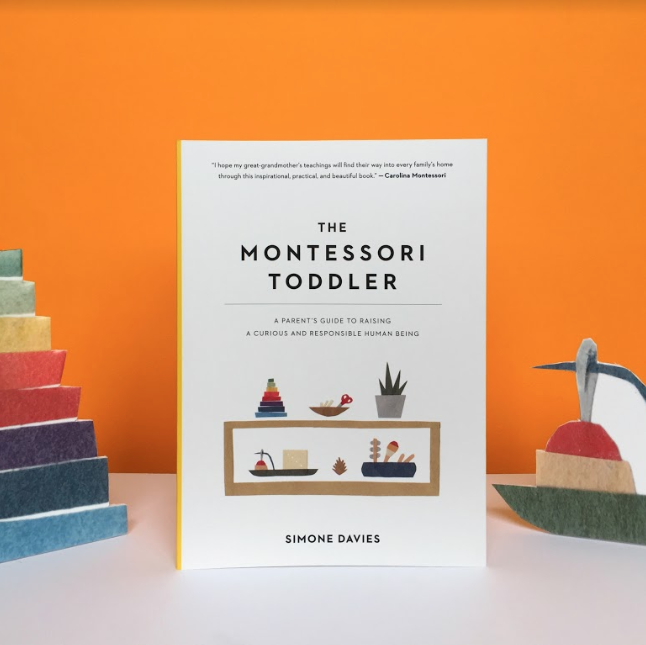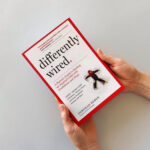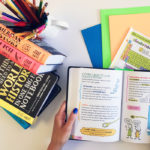What is the Montessori Method?
Montessori education is not to fill a child with facts, but to cultivate their own natural desire to learn. Children naturally love to make discoveries for themselves and come up with creative solutions.
A key to raising curious humans is to encourage creativity. In the excerpt below, Simone Davies, author of The Montessori Toddler and an AMI (Association Montessori Internationale) teacher, shares how you can use Montessori principles in your home to inspire creativity in your toddlers.

Encouraging Creativity
“The more experience a child has with real purposeful activity and solving problems, the more useful, creative, and effective her imagination will become.” —Susan Stephenson, The Joyful Child
There is a common misconception that the Montessori approach does not support and encourage children’s creativity and imagination. Reasons cited include the fact that Montessori materials are for a specific purpose rather than being more open-ended, that we do not have a pretend-play corner in our classrooms, and that we do not encourage fantasy in children under 6 years old (rather, we focus on the concrete world around them).
Imagination is different from fantasy
Fantasy means making up something that does not exist in reality. Children under 6 don’t easily perceive the difference between something that is made up and something that is real. In a research study, “Do Monsters Dream? Young Children’s Understanding of the Fantasy/Reality Distinction” by Tanya Sharon and Jacqueline D. Woolley, young children were shown fantastical and natural pictures of animals. The 3-year-olds had difficulty distinguishing real from fantastical scenes. We may witness this when a child is scared by something in books or other media, from dragons and monsters to images they see on the news. It can feel very real to them. Imagination, on the other hand, is used when our mind takes the information we have collected and comes up with creative possibilities. In Montessori, we lay the foundation for our child in the first years in reality, planting the seeds for their life as creative and imaginative citizens of the world. To establish a strong foundation, we can provide our children with hands-on experiences in the real world in the early years. Around 2.5+ years, we will see our child begin with pretend play. This is a sign that they are processing what they see around them (imagination). They play families, bake us cookies, and pretend to be the schoolteacher. They are being creative without becoming overwhelmed by the idea of dragons, monsters, or other things they can’t see or experience directly (fantasy). When providing materials for such play, we can keep the items less prescriptive—scarves and other objects can be used in many ways, whereas a firefighter’s suit can be used in only one way. The focus on reality won’t limit their creativity; it will enhance it. We can see the groundwork flourish in adolescence when the imagination becomes particularly strong and they start to come up with creative solutions to our world problems and for social change.
What about artistic creativity?
We can provide a rich and inviting area for artistic creativity. We can:
•• Set up beautiful materials at our child’s height.
•• Create invitations for creativity—beautiful trays with age-appropriate materials to explore.
•• Make beauty part of our home, including art and plants, which they will absorb and be inspired by.
•• Choose quality over quantity when it comes to the materials.
In addition, there are key principles that we can practice to support our child’s development of their artistic creativity. We can:
•• Invite open-ended use of materials (use fewer art kits and coloring books, which are more prescriptive).
•• Prepare ourselves to encourage creativity—allow time and be open to allowing mess and exploration; prepare a space that is okay to get dirty; relax, join in, and create together.
•• Ask, not tell. Rather than instructing our child, we can encourage exploration.
•• Allow boredom. When we have unscheduled time in our day to sit without anything planned (and without technology to entertain us), our child has a chance to be bored. Their mind can wander and daydream, they can come up with new ideas, and they can make new connections. When the mind is bored, it seeks stimulation and becomes increasingly creative.
•• Look at the process, not the result. Focus on our child’s effort by describing their effort. “You made big circles.” “I see you mixed these two colors.”
•• Show our child that there are no mistakes in this work. We can experiment and learn when things don’t turn out the way we expected. Most of all we can have fun inspiring, exploring, and creating with our child.
More About The Montessori Toddler:
 It’s time to change the way we see toddlers. Using the principles developed by the educator Dr. Maria Montessori, Simone Davies shows how to turn life with a “terrible two” into a mutually rich and rewarding time of curiosity, learning, respect, and discovery. With hundreds of practical ideas for every aspect of living with a toddler, this book, full of bright, airy design and colorful illustrations and photographs, captures the feelings and conveys the values of a real Montessori classroom—now in your home.
It’s time to change the way we see toddlers. Using the principles developed by the educator Dr. Maria Montessori, Simone Davies shows how to turn life with a “terrible two” into a mutually rich and rewarding time of curiosity, learning, respect, and discovery. With hundreds of practical ideas for every aspect of living with a toddler, this book, full of bright, airy design and colorful illustrations and photographs, captures the feelings and conveys the values of a real Montessori classroom—now in your home.
Buy the Book
Amazon | B&N | Indiebound | Workman





1 Comment
Darwin Montessori
July 25, 2019 at 9:32 amA Montessori classroom is a thoughtfully designed environment to offer children opportunities to develop their own capabilities. Each classroom is filled with developmentally appropriate activities that encourage children to interact with specific learning materials, as well as to work cooperatively with others.